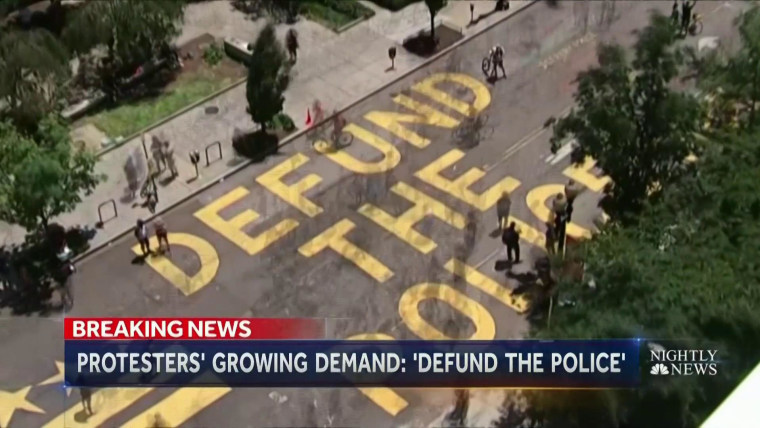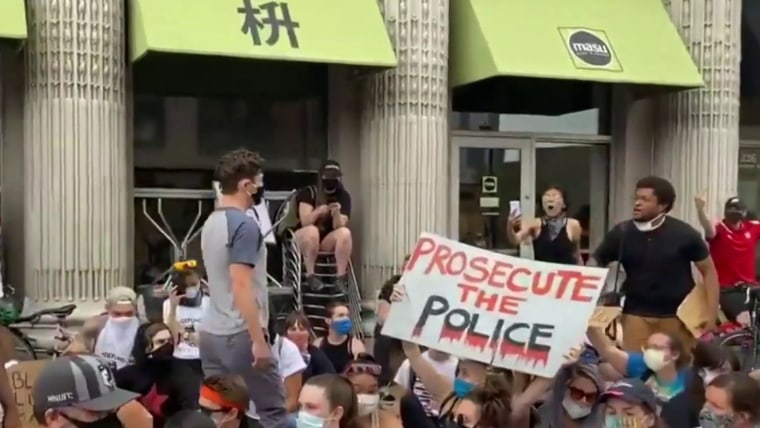When District of Columbia Mayor Muriel Bowser had “Black Lives Matter” painted on the street that leads to the White House on Friday, Dominique Hazzard said it “stung.”
A black D.C. resident and organizer with the Black Youth Project 100, Hazzard said she’d like to see policies from the mayor that showed she was dedicated to materially improving the lives of black Washingtonians, not just a road display. So on Saturday, BYP 100 staged an action, painting “Defund the Police” next to Bowser’s message.
“It is important to keep focus on our city’s local issues and the lives lost to prisons and police here in DC,” Hazzard said.
Hazzard wants to see her city’s police department defunded, a call that has grown across the country as protests against police brutality continue in the wake of the murder of George Floyd and countless other black people killed by police.
For more on this story, tune in to NBC Nightly News with Lester Holt tonight at 6:30pm ET/5:30pm CT.
But amid the protests, different—but sometimes overlapping—proposals for how to address police violence in the U.S. have emerged, from reforming to defunding to dismantling to abolishing the police.
REFORM
Police reform has often been the mainstream call in the wake of protests against police brutality. A long-term process that has usually involved putting more funding towards police, reform now tends to call for community policing, a style that encourages police to be assigned to a specific community and know the residents and dynamics of the area where they work. In his criminal justice plan, presumptive Democratic presidential nominee and former Vice President Joe Biden calls for $300 million to be allocated towards community policing, saying it’s the model that makes policing work best.
Police reform also focuses on limiting officer use of force and holding police accountable.
On Monday, House Democrats introduced the “Justice in Policing Act,” a police reform bill that would ban chokeholds, including the kind used to kill George Floyd, as well as no-knock warrants in drug cases, used in the case that led to the fatal shooting of Breonna Taylor.
The legislation would also require local police departments to send data on their use of force to the federal government and create a grant program that would allow state attorneys general to create an independent process to investigate misconduct or excessive use of force, according to the five-page summary of the bill.
Reforms have also been proposed under “8 Can’t Wait,” an initiative released in the wake of the recent protests by Campaign Zero, a group advocating police reform. The campaign has called for banning chokeholds, requiring de-escalation, mandating a warning before shooting, a ban on shooting at moving vehicles, and would require a use of force continuum, among other things.
DEFUND
But many say reform doesn’t work and argue that departments like the Minneapolis police have already undergone reform and police violence still happens.
Instead, activists, organizers, scholars, and city residents are furthering the call, demanding police be defunded, often under a “divest/invest” model.
Those calling for defunding the police see the departments’ budgets as bloated and misappropriated when other crucial city services have to beg for scraps.
In D.C., “it would look like taking the money and using it on things that would actually make our communities safer,” Hazzard said. To her, and others, that could take many forms, like investing in violence prevention programs, public housing, health care and mental health care, and better support systems in schools instead of armed guards.
“There are a lot of police in my neighborhood, parked on the street all day everyday,” Hazzard said. “I have to ask myself: Is that making my neighborhood safer?”
She thinks not. “It shouldn’t be that we are out here begging for a hospital or a supermarket and the police budget just gets an increase every year,” Hazzard said.
One example of a divest/invest model of fighting for police defunding is the “No Cop Academy” campaign in Chicago. Then-Mayor Rahm Emanuel closed dozens of schools in the city in part citing budget issues, but later proposed a new police and fire training academy at the cost of $95 million.
No Cop Academy formed to fight to get the mayor to put that money into the community instead.
“Chicago already spends $1.5 billion on police every year—that’s $4 million every single day. We spend 300% more on the CPD as a city than we do on the Departments of Public Health, family and support services, transportation, and planning and development (which handles affordable housing),” the group says on its website.
Naomi Murakawa, an associate professor of African American studies at Princeton, said that while calls for defunding the police have been going on for decades, this moment strikes her as different.
“What we tend to see is that police brutality and police crises become moments for police to get more money for themselves,” Murakawa said. In the 1960s, President Lyndon B Johnson created a commission to look at policing after the civil rights movement, which resulted in billions of dollars of federal dollars going to local police departments, she said.
“Every time people rise up against police to demand change, police essentially benefit from it,” Murakawa said. Now, she said, the call defunding the police reveal a “shift in consciousness.”
“People are saying we are doing it differently this time,” she said.
DISMANTLING
On Sunday night, a majority of the Minneapolis City Council agreed to dismantle the city’s police department.
In an interview with NBC News, Councilman Jeremiah Ellison said the council would work to disband the department in its “current iteration.”
“The plan has to start somewhere,” he said. “We are not going to hit the eject button without a plan, so today was the announcement of the formulation of that plan.”
But the decision to dismantle the police department doesn’t mean the city will just form a new one, as Camden, N.J., did when it dismantled its department.
After disbanding its force in 2012, Camden created what city leaders say was a different kind of police force, focused on community policing, but the city still very much has a police department.
Sometimes departments disband when municipalities go bankrupt or when a city decides it doesn’t want to pay for its own police and contracts a neighbor’s force instead.
“I don’t think any of those efforts at disbanding, including the one in Camden, were undertaken with the intention of replacing the functions through a completely different paradigm of meeting community needs,” said Andrea Ritchie, a researcher for Interrupting Criminalization at Barnard College and author of “Invisible No More: Police Violence Against Black Women and Women of Color.”
In Minneapolis, though, it appears a paradigm shift might be the goal. Mayor Jacob Frey was booed by protesters after he refused to commit to defunding the police, and many activists on the ground in the city have made it clear a leaner, more progressive police department is not their goal.
“The Minneapolis Police Department has proven themselves beyond reform,” U.S. Rep. Ilhan Omar, a Democrat who represents the city, wrote on Twitter. “It’s time to disband them and reimagine public safety in Minneapolis.”
ABOLITION
Then, there’s abolition, an often misunderstood framework to reimagine the way society responds to harm. For some, defunding the police just means reducing its budget, but for others it means taking a step towards abolition.
To abolish the police, Ritchie says, goes beyond slashing a budget, and rejects policing and prisons as a reformable institution.
“Even if we trim the budget, if we ask them to do more beating with less money, we’re still invested in policing as an action, institution and method of meeting need and reducing conflict,” she said.
Instead, those who call for police abolition want to see an end to policing long term while still addressing community needs.
“It’s about determining what helps a community thrive,” Ritchie said, citing the work of black scholars and abolitionists Angela Davis and Ruth Wilson Gilmore. “Abolition is a process of building, a process of creation, a process of reimagination.”
Abolitionists say their goals aren’t just to close a police department, but rather to change the structure and conditions under which people who are currently criminalized live to make police more obsolete. If people had healthcare and housing and access to good jobs and education and community, there would be less crime and less need for police, they posit.
This thinking includes building community processes to deal with harm when it has been done, Ritchie said.
“People say, ‘What about sexual violence and what about domestic violence?’” Ritchie said. “The people who are advocating defund police and abolish police are for the most part, black women, girls, trans, and gender nonconforming people, many of us are survivors of all those forms of violence.”
“We are not proposing to abandon our communities to violence. We are naming policing as a form of violence that we all experience.”













